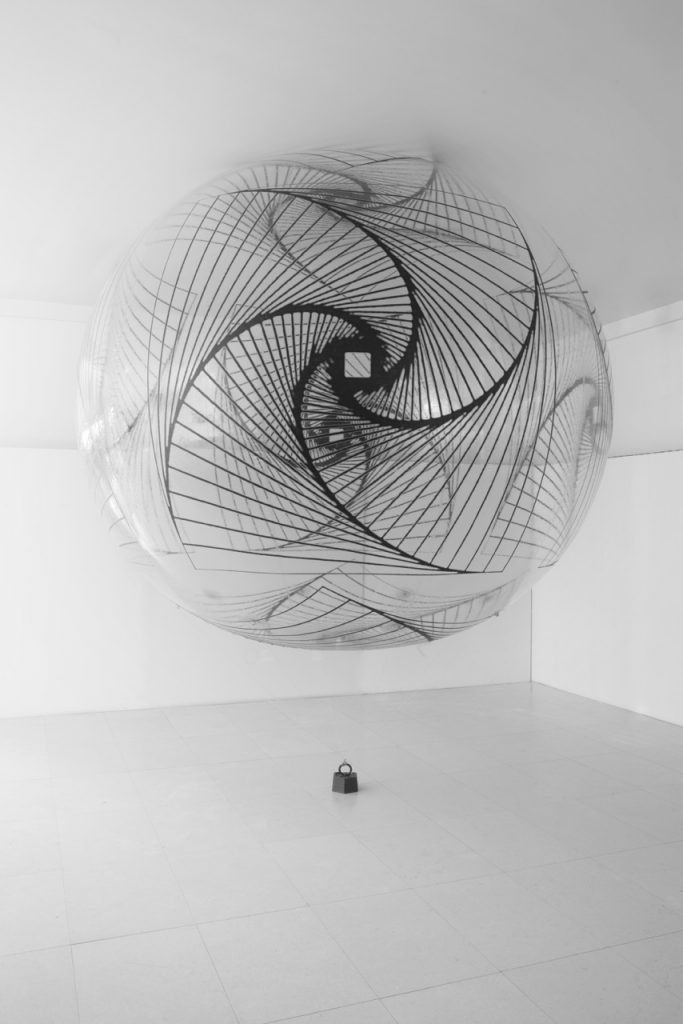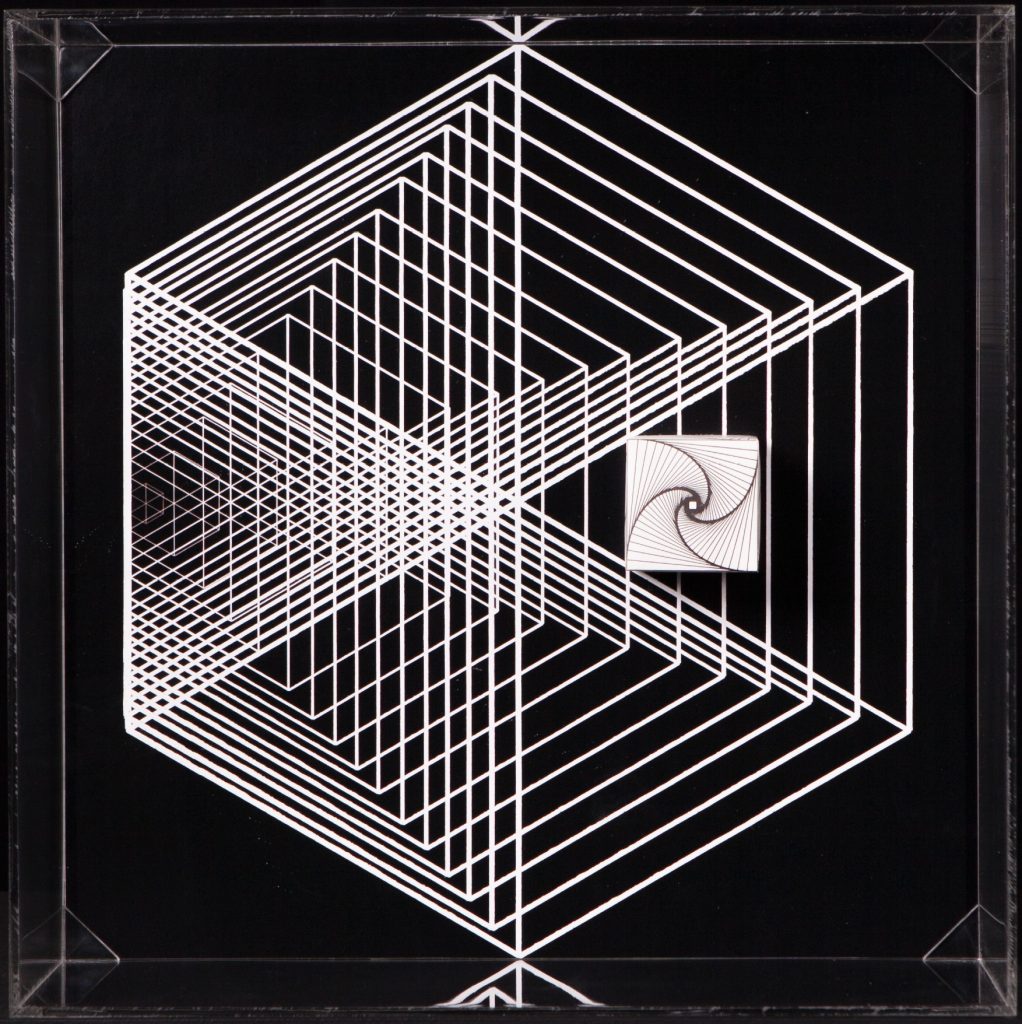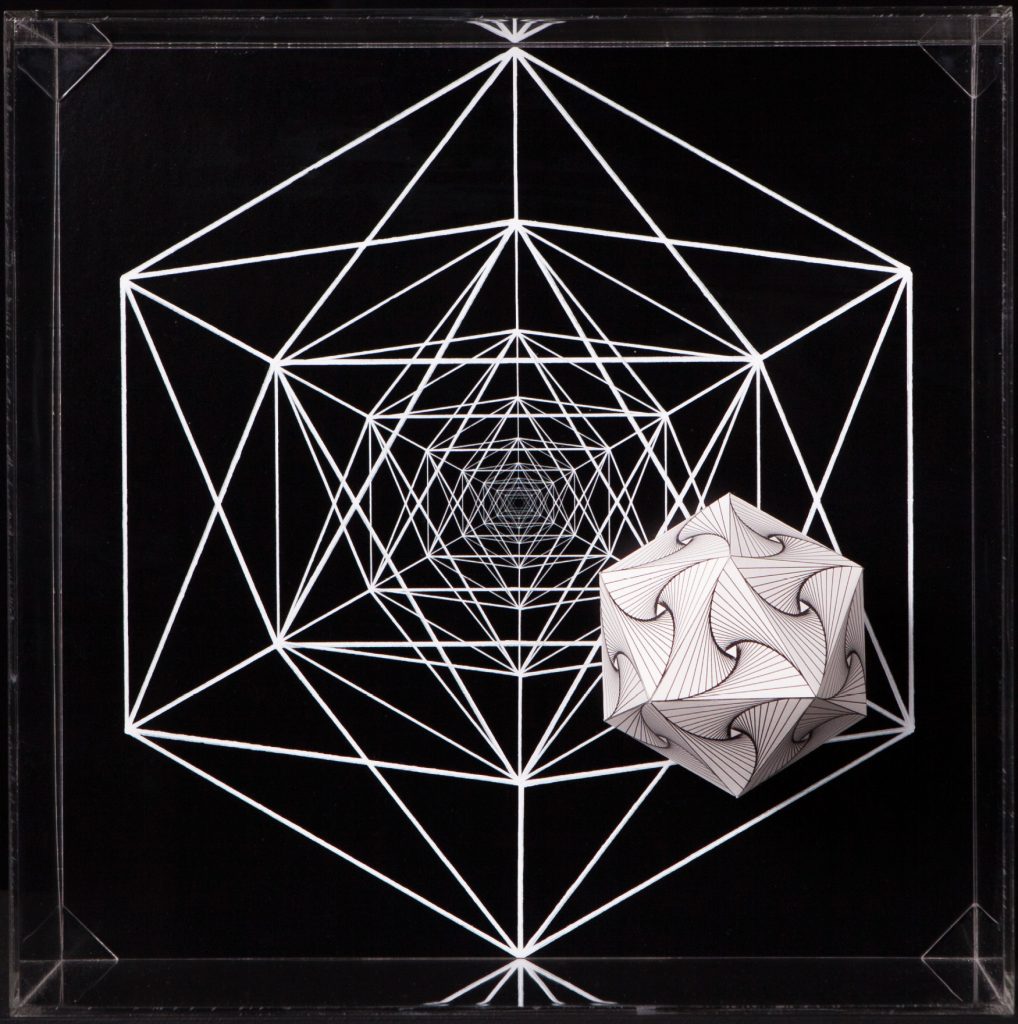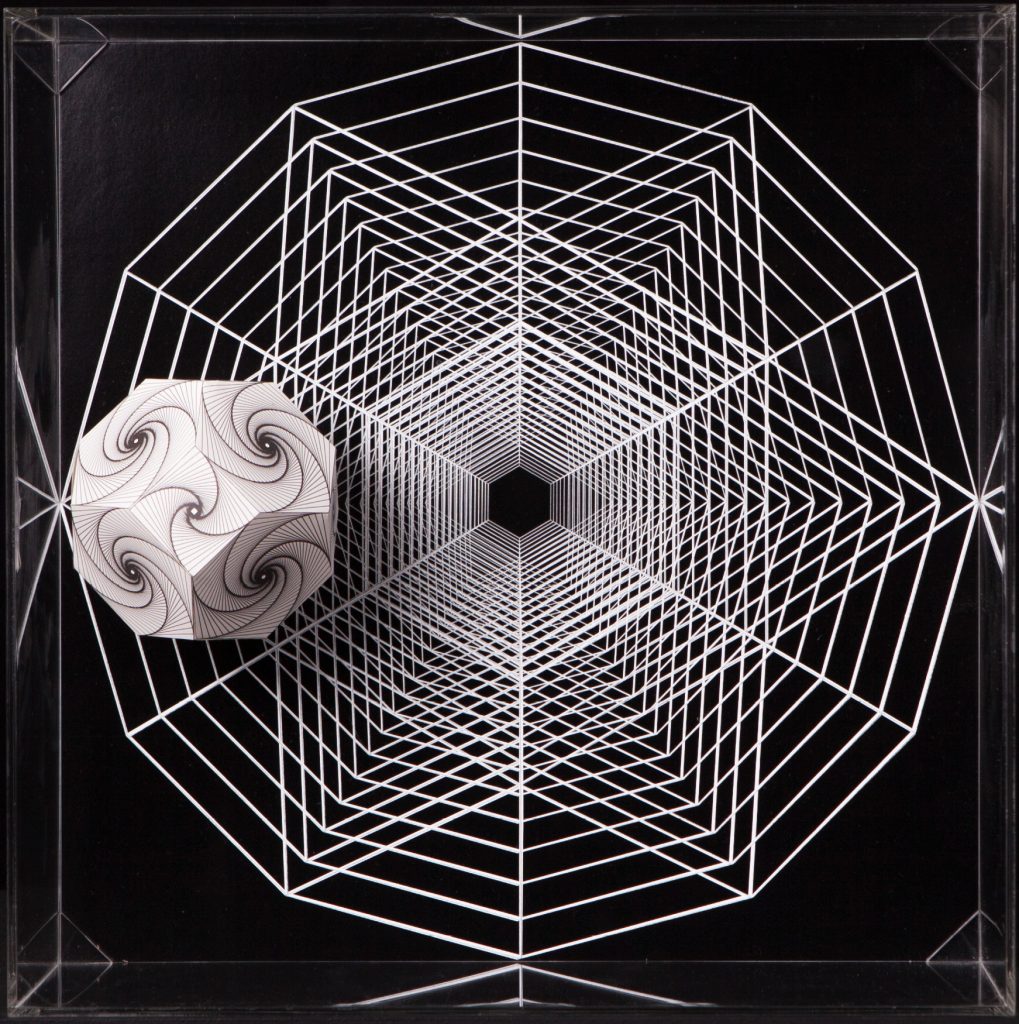On Perception, Geometry, Independent Realities and Transcendental Archetypes: A Conversation with Margarida Sardinha
Independent artist and director born in Lisbon in 1978, Margarida Sardinha works with a wide range of media, from site-specific installation to film and optical animation, and from performance to text and sound, photography (double exposure on film is one of her all-times favorite ways of experimenting) and symbolic study drawings – all translated, in the artist’s own words, into „abstract minimal works” and „geometrical optical illusions”.

Rhomboid
In just a few days, Margarida Sardinha has the opening of a special event – a powerful, monochromatic show of artworks, focusing upon points, distances, polyhedra and shadows – Hyperbolic Hyparxis1 or a complex visual Journey, deeply connected to archetypal symbols and some of the world’s most forward-thinking theories, as well as showcasing the artist’s personal views on, among others, the four-dimensional space-time theory2. And, while Margarida is taking care of the final preparations for this black-and-white-only, site-specific exhibition that will lead us – through film and print, via series of 3-d poligonal sculptural cases and through a huge printed floating sphere – into a mesmerizing optical universe, I am trying to find out the source (or sources) that trigger the artist’s original approach.
https://player.vimeo.com/video/209545979
We agreed to meet at the studio – a serene place just one hour away from the vibrant Lisbon city center, a simple yet elegant countryside house with tall rooms, wooden floors, large windows and a nice small back garden. Margarida started by giving me the tour of the studio and, while we pass rooms filled with books, sketches, prototypes and finished pieces, all the complex questions I had in mind seemed to slowly fade away. I noticed several walls filled with beautiful, large-scale schemes, elegant line drawings in various colors, in fact variations on an originally hand drawn matrix that takes eight of the universal symbols, among which the tree of life and the yin and yang, and combine, then overlaps and superimposes their shapes, aiming to finally turn everything into a single, intricate shape.
And it was exactly this very intricate shape that simplified everything. Seen through this special kind of „lens”, all the artworks around, regardless the theme, the chosen media or the stage, seem to be a constant – a constant reflection upon geometric symbols as mirrors of the worldwide science, communication and human behaviour. „An analogical but not arithmetical reflection” points out Margarida. „An exploration of the mind generated relationship between sign and symbol, through constant repetition, mapping a random, mental, atemporal line.”

Truncated Icosahedron
The studio tour comes to an end and we sit down, continuing our conversation over hot tea, the idealised Euclidean space („what we conceive and what reality is are two different things”), ways to visually convey memory like in the Rorschach tests (for the London Memory multi+city film), VJ-ing as one of the turning point experiences of Margarida’s ten years of London residency and… evertyhing in-between:

Hyperbolic Curves (Printed on a 3m Diameter, Helium Filled, Transparent Sphere)
If we were to define your artwork briefly, in a kind of an artistic statement, what aspects would you highlight?
I have a holistic vision on life, in general, and in art, particularly, I believe everything is interconnected. Thus, I choose to inquire much about the past and the future, for I think that most of what I do has already been done before and we only have an illusion, however persistent (as Einstein put it3) of this past/future duality that compels us to constantly look for something new. Hence, if I were to highlight something on my work it would be the continuous search for understanding duality as oneness.

Cylinder
You work with archetypal geometrical symbols. What determined you to choose this specific path?
We live in a fleeting world where everything changes from one minute to the next, making change – our only constant; yet, archetypes are also constants, for they are changeless and timeless. I am interested in such concepts and feelings – things that cannot be overturned by time or space like faith and love or archetypal symbols.

Great Stellated Dodecahedron
Where do you take inspiration from?
I am not very fond of the word „inspiration” for I believe it to be overrated and misused. I only admit the use of the word inspiration when it refers to God’s enlightenment, which sometimes happens to some people. We, artists, have interests, perceptions and understandings that many times simply come from continuous work. That perception or understanding of my interests comes mainly from reading and studying religion, science and art.

Cross of Octahedra
Then could you please point out some names that influence you?
In art, I am particularly fond of Anish Kapoor, James Turrell, Michal Rovner and Howard Hotchkins. Among many, many others.
And, since you said that your interests comes mainly from reading, which is the last book you’ve read?
Keith Critchlow’s Hidden Geometry of Flowers.

Small Stellated Dodecahedron
Your work features site-specific installations, text, sound, image, experimental film and photography. How did you come to such a wide choice of media?
Most of my work starts with a film. Then I take still images and turn them into 2-d or 3-d objects. Actually, the story goes like this: I started painting extremely young and my parents appointed me a personal tutor, aside from school, who taught me art history, drawing and painting for seven years. So, I went to London being sure that I want to study painting. Then, when I enrolled at Central Saint Martins College of Art, I immediately engaged with conceptual art – in which the medium reflects the concept of the work, choosing Fine Art Combined Media. Thus, each time I use a different medium it refers to a specific aspect of the idea that I developed and that I want to convey.

Third Stellation of Icosahedron
Many of your artworks relate to the concept of symmetry. Where does this particular interest come from? And what about asymmetry, where does asymmetry lead to, compared to symmetry?
Coxeter4 defined symmetry: „When we say that a figure is ‘symmetrical’ we mean that there is a congruent transformation which leaves it unchanged as a whole, merely by permuting its component elements.” However, there’s a mathematician, theoretical physicist and philosopher of science that I am also very fond of, named Henri Poincaré, who, in his work on planetary orbits, was the first to consider the possibility of chaos in a deterministic system, which laid the foundation of modern chaos theory. He is also considered one of the founders of topology for a space in any dimension and proved the Euler-Poincaré theorem relating the number of edges, vertices and faces of n-dimensional polyhedron.
But what I most appreciate is the Poincaré’s disk model for hyperbolic geometry that was conceived by Beltrami and later rediscovered by Poincaré. For me, his life’s work reflects exactly what I am interested in, that is, a balance of dualities that only geometry can allow, a sort of union between symmetry and asymmetry, chaos and harmony, finite and infinite.

Truncated Icosidodecahedron
Hyperbolic Hyparxis will be soon on display in Lisbon. Why did you choose the black and white, here?
Hyperbolic Hyparxis is my first ever monochromatic exhibition and it is due to the fact that it is solely based on geometry, in this case, it focuses on the parallel postulate in Euclidean and hyperbolic geometries which is a sort of dissonance between the two.
On my previous works, usually related with comparative religion, mysticism or literature, I employed feelings such as: faith, memory, mercy, enlightenment and love, I also included geometry in them but it wasn’t their root idea; this happens according to a continuum matrix of colours and symbols that I conceived a long time ago where I assigned a specific symbol and colour to a feeling or an idea and the black and white symbol is the yin and yang that in this matrix embodies the idea of mirror, in this case, standing for mirror symmetry which is an equivalence between Calabi-Yau manifolds5.

Truncated Tube
And what is the relationship between the geometries and the Shadow Symbols?
Shadow Symbols is a sub-series of Hyperbolic Hyparxis – it comprises 36 works containing a digital background photograph and a three-dimensional polyhedron overlaying it. The background is a liminocentric or fractal construction using the tessellation of the polyhedron placed above and it not only looks like its shadow projected on the ground, but it also resembles religious and mystical symbols of times past.

Rhombicosidodecahedron
Hyperbolic Hyparxis refers, among many others, to multiverses. Can we discuss your personal vision on this matter?
I am a supporter of M-theory, which includes superstring and supersymmetry therefore I see the universe as a multiverse in eleven spacetime dimensions.

Stella Octangula
igloo is a magazine focusing upon contemporary architecture and urban space. How do you see the relationship between archetypal symbols and contemporary architecture?
Archetypal symbols are the basis from which everything we humans can perceive springs. The deconstruction of these concepts requires their full understanding and I think few architects do this well these days, but the ones who do, do it extremely well.

Icosidodecahedron
Does contemporary architecture still speak the language of universal symbols? Or has it lost some of its touch, in search of appearance and cost efficiency?
I believe that it is a matter of choice and knowledge to encompass universal symbols in one’s work, be it architecture or any other art, thus I will simply give the example of the Institut du Monde Arabe in Paris by Jean Nouvel.

Cube
Would you please name a building that you consider geometrically outstanding.
I will name two because I cannot say which I like most – the Great Pyramid of Giza and Rome’s Pantheon.
And would you please name a geometrical shape or symbol that would best relate with the city of Lisbon.
I believe everyone would agree to assign the icosahedron to Lisbon for it is the Platonic polyhedron relating to water.

Icosahedron
Notes:
1. Hyperbolic Hyparxis is an exhibition comprising 60 new works by the artist Margarida Sardinha for the Faculty of Sciences of the University of Lisbon. The monochromatic site-specific exhibition consists of Hyperbolic Hyparxis – an experimental film, Hyperbolic Curves – a 3 meter diameter floating sphere filled with helium, Hyperbolic Polyhedra – 4 large scale sculptures, Shadow Symbols and Points, Lines and Distances – 36 and respectively 20 works containing a digital background photograph and a three-dimensional polyhedron overlaying it. The five sets of works complement each other in a liminocentric way, thus, they repeat each other akin to recursive definitions in hyperbolic spaces. Its general concept relates to the following scientific, mathematical and geometrical notions.
2. Hermann Minkowski is perhaps best known for his work in relativity, in which he showed in 1907 that his former student Albert Einstein’s special theory of relativity (1905), could be understood geometrically as a theory of four-dimensional space–time, since known as the „Minkowski spacetime”.
3. „The distinction between the past, present and future is only a stubbornly persistent illusion” said Albert Einstein.
4. H.S.M. Coxeter is regarded as one of the greatest geometers of the 20th century. He worked for 60 years at the University of Toronto and published several books on The Beauty of Geometry, The Regular Polyotopes, Non-Euclidean Geometry or Mathematical Recreations & Essays. He was most noted for his work on regular polytopes and higher-dimensional geometries.
5. A Calabi-Yau manifold is a complex manifold that is a generalization of K3 surfaces in any number of complex dimensions (meaning any even number of real dimensions), a special type of manifold that is described in certain branches of mathematics such as algebraic geometry. Its properties also yield applications in theoretical physics. Particularly in the superstring theory, the extra dimensions of spacetime are sometimes conjectured to take the form of a 6-dimensional Calabi-Yau manifold, which led to the idea of mirror symmetry.

Truncated Octahedron
A Brief Artist’s Biography
Margarida Sardinha opens, on April the 6th, a solo show of new work, Hyperbolic Hyparxis, at the Science College of the University of Lisbon.
In November 2016, at The New Art Fest ’16 organised by Ocupart and curated by António Cerveira Pinto, she presented the digital animated film Knotwork at the Web Summit and also showed the digital film London Memory multi+city at Sá da Costa Bookshop in Lisbon.
In 2014-16 Margarida Sardinha had three major solo shows of the exhibition Symmetry’s Portal at the Aga Khan Foundation’s Ismaili Centre in Lisbon, at Carousel-London in London and at Ericeira Cultural Centre. Limited editions based on the show were be exhibited at London’s Opera Gallery in November 2015 part of the Reflections group exhibition curated by Neil McConnon.
Margarida Sardinha is the director of Hyperbolic Hyparxis (2015), Master Mercy Matrix (2013), London Memory multi+city (2013) and HyperLightness ad absurdum (2011), experimental films, winners of many film festivals worldwide.
She has also exhibited her site-specific installation work both in museums, galleries and biennales in London, Lisbon and New York, the most important being: the solo show Darkness Reflexions at the Fernando Pessoa Museum. I comprised three site-specific installations As Above, So Below…, The Gods Have Not Died…, Darkness Reflexions and Darkness Reflexions Sketchbook, an 80 page exhibition catalogue.
Margarida was also one of the founders of the London based group pARTart and the curator of the group’s exhibition London Recycled at the Menier Chocolate Factory comprising 22 new works by the London based artists from 10 diverse artistic discipline’s backgrounds and 11 different nationalities exploring London’s multiculturalism and multidisciplinary pluralism. Through the show and its collateral promotional and fundraising events where she performed Vjing at several London’s East End venues along with the performances of invited emerging music bands and other members of the group live pieces, she created over one year the necessary conditions for these artists to produce new work re-accessing their respective individual cyclic experience of London’s living making it a collective mirror of the city arts scenery.
She also won the Prize of Jovens Criadores (Young Creators Prize) awarded by the Portuguese Cultural Ministry and the Grupo Artes e Ideias in 1999.

Cone
HYPERBOLIC HYPARXIS will be on display from April 6th to July 6th, 2017, at C6 Building, Faculdade de Ciências da Universidade de Lisboa, Campo Grande, Lisbon.
Artist:
Organizer of the exhibition:
http://www.helderalfaiategaleria.com/



